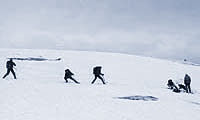|
|
|
Glacier hiking could be dangerous. A fall might cause human injury. And it could be difficult to get help.
It's important that everyone in the team know what to do. Usually it's more risky when walking on snow, it's hard to see the cracks.
|

|
|
The first thing to do when someone has felt is to inform all the others in the team and hold the rope firm to prevent that the fallen will go further down the crack (faster the better).
When the team got control they must try to get contact. That could sometimes be impossible. If the team is a large one they probably manage to pull up the fallen without the rescue method given below. When it's a snow crack you might get problem with the rope cutting itself into the snow masses at the edge.
If the person is bad injured someone has to climb down and perform first aid and fasten the help carbine in the harness.
|
|
|
Force knot climbing
-
With the help of a short and a long force knot sling the fallen climb up the crack himself. You put a long sling on the rope and then alternately stand in the long sling and sit in the short sling. The short one is already fastened on the rope. Put your leg in the long and raise, then moves the short upwards as long as it goes. Then proceed until you're up.
-
You should fasten an anchor before the fallen begin to climb, snow anchor or ice screws, depends on the surface.
|
|
Rescuing with carbine and a pulley
If you don't manage to pull up the fallen with the above-described methods you can use a carbine with a pulley.
From old physics you half the force by using this method. But you must pull the rope much longer. Important is that the rope doesn't scroll.
The methods various a little depending on how many persons there is in the team. The example below is for a three people group where it's most common that the first person falls.
-
After the fall the second person get contact. It's difficult in bad weather.
-
Then he secures with an ice screw or a snow anchor. On the anchor he also fasten a screw carbine with a force knot sling connected to the main rope. Next step is to fasten another force knot sling to the main rope close to the crack. The third man will use this sling.
-
Now the main rope could be unloaded and the fallen will hang in the anchor.
-
The third man moves forward with stretched rope and passes the second man, then ties himself with the sling the second man prepared just before.
-
The third man is now secured and therefore he could move to the edge and talk to the fallen. The rescuing will continue with the carbine & pulley method if he's not hurt.
-
The rope between the second and the third will now become a help rope.
-
Another anchor is fastened by the third man and he now disconnect from the rope and connect to the anchor instead. Then he put the carbine with the pulley into the help rope, which is sent down the crack. When the carbine is down the fallen fasten it to his harness and then the third and second just pull the fallen upwards.
-
If it's a snow crack you use an ice axe or a back pack at the edge of the crack as support for the rope. Otherwise the rope is cutting it self through the snow and it's impossible to pull anymore. Don't forget to secure with a sling to an anchor.
-
Everyone must be secured while rescuing and afterwards you organize the team immediately, the risks have not ceased.
|
Intro | Facts | Equipment | Knots | Safety technic | Comrade rescue
|
|
|